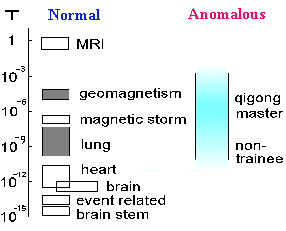- 4. EEG Change in Remote Perception Task Using Electromagnetic Shield Cage 4)
- A qigong master (sender) and his pupil (receiver) were in two different rooms in a sensory-shielded state, and anomalous perception by qigong was attempted while the receiver was connected to an electroencephalograph. The sender attempted to transmit qi within a few seconds at a randomly selected time in 80 seconds period. The receiver, who was seated in an electromagnetic shield cage, attempted to perceive the transmission time. The analysis of the electroencephalogram from 20 seconds before to 20 seconds after the qi emission showed that a statistically significant increase of alpha wave mean amplitude at C3 point occurred around 15 seconds after starting qi emission. The C3 point corresponds to a sensory area of the right hand in which the receiver held a switch by which she signaled the guessed time. This result was consistent with results of our past experiments that the alpha wave amplitude in the receiver's electroencephalograms increases for his/her sensory area related to the loaded anomalous perception task at 10 or more seconds after the start of the anomalous stimuli. But the present experiment had a difference from the past experiments on the point that the anomalous stimuli were not sent at the time of the brain reaction which suggests anomalous perception in the subconscious.
 References
References
1a)
Kokubo H, Yamamoto M, Hirasawa M, Kawano K, Furukawa M and Sakaida H: Proceedings of 31st Annual Convention of JSPP, pp.15-19, 1998.
1b)
Kokubo H, Yamamoto M, Hirasawa M, Kawano K, Furukawa M and Sakaida H: Journal of International Society of Life Information Science, 17(1): 20-31, 1999.
2a)
Kokubo H, Yamamoto M, Hirasawa M, Kawano K, Furukawa M and Sakaida H: Proceedings of 31st Annual Convention of JSPP, pp.20-25, 1998. [in Japanese]
2b)
Kokubo H and Yamamoto M: Yunnan's procedure of screening test for anomalous somatic functions, Japanese Journal of Parapsychology, 4(1):3-11, 1999 [in Japanese]
3) Kawano K, Yamada T, Hirasawa M, Kokubo H and Yamamoto M: Journal of International Society of Life Information Sicence, 17(1): 78-82, 1999.
4) Yamamoto M, Hirasawa M, Kokado T, Kokubo K, Yamada T, Taniguchi J, Kawano K and Fukuda N: Journal of International Society of Life Information Sicence, 17(1): 191-197, 1999.
Go to Results of Former Year
Go to Results of Next Year
Return to Home
Last Modified: February 4, 2000
Maintained by KOKUBO Hideyuki
Questions, comments, or problems for this page:
kokubo@a-iri.org
 Project Activity (Fourth Year)
Project Activity (Fourth Year)
 Project Activity (Fourth Year)
Project Activity (Fourth Year)
 Researches in the Fourth Year
Researches in the Fourth Year

 References
References